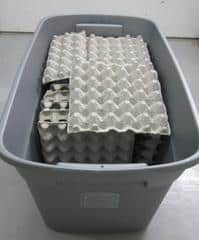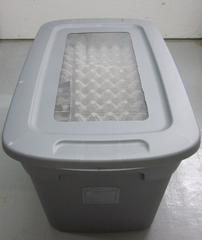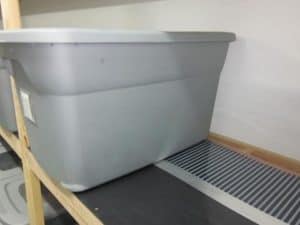Blaptica dubia, also known as “dubia” are native to Central and South America.
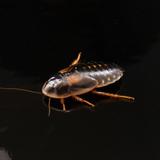 Adult Dubia roaches are sexually dimorphic, the males will have full wings down the length of their backs while females will only have wing stubs. Adults and juveniles cannot climb smooth surfaces such as glass or plastic totes commonly used to house them. Some of the very small nymphs are able to climb the plastic totes if they are rough enough. Dubia cannot fly although adult males can “flutter fall” where they slowly fall and can move horizontal a few feet. They cannot gain altitude though.
Adult Dubia roaches are sexually dimorphic, the males will have full wings down the length of their backs while females will only have wing stubs. Adults and juveniles cannot climb smooth surfaces such as glass or plastic totes commonly used to house them. Some of the very small nymphs are able to climb the plastic totes if they are rough enough. Dubia cannot fly although adult males can “flutter fall” where they slowly fall and can move horizontal a few feet. They cannot gain altitude though.
Female Dubia roaches generally live around 18 months while male Dubia roaches will only live around 8-12 months. Nymphs can mature around 4 to 6 months but this time frame depends on temperature and care. Each Dubia roach will molt 7 times from the time it is born to the time it reaches adult. A freshly molted roach will appear white and gain its dark color over the next 24 hours. Females produce on average 20-30 nymphs every 6-8 weeks.
Housing
There are several different Dubia roach housing options that can be used. If you are planning on keeping a small colony to feed one or two pets then a small 10 gallon glass aquarium can be used. If this method is used it is best to paint the outside of the aquarium black as the roaches do not like light. A screen top works best to allow for air exchange.
The other commonly used housing is plastic totes/tubs. These can range in size from 5-60 gallons. It is best to choose a dark opaque color rather than the clear style. When using these plastic totes all that is needed is for the center of the lid to be cut out and screen attached. This can be done by hot gluing window screen into the cut out area. I prefer to cut out most of the lid area, probably around 50-75% open. You can use aluminum or fiberglass window screen. Egg crates can then be stacked inside of the enclosure to give more surface area for the roaches to climb on.
Heat
A heat source is only needed if you plan on breeding your own Dubia. If you are purchasing them only to be used as a feeder source then no extra heat is needed. They will do fine with normal household temperatures.
Different heating option include: reptile heat mat, human heating pad, incandescent light bulb, ceramic heat emitter and heat tape.
- A reptile heat mat is made to stick on the bottom of a glass aquarium. These can not be used on plastic totes.
- Human heating pads can be used on both glass and plastic. It is important to find one that does not have a no auto shut off function. This is not a very efficient way to heat as there is usually only a few settings to adjust the heat.
- An incandescent bulb in a reflector can be sued suspended above the screened lid. This is my least preferred method of heating as it is inefficient, hard to control temperatures, reduces humidity, high long term cost (bulb replacement) and is the least safe.
- Ceramic heat emitter is set up the same as the light bulb, I do not like them for the same reasons as above.
- Heat tape is by far the best way to heat a Dubia enclosure. This is what we use in our facility. It does have a slightly higher up front cost but last for a very long time. Heat tape must be used with some sort of power limiting switch. Either a dimmer switch or a rheostat.
Water

Water should be supplied to your Dubia roaches with water crystals. This is the easiest and healthiest way to allow your roaches to stay hydrated. One ounce of crystals will make a gallon of water crystals ready to use. The use of water crystals keeps the roaches from drowning and will also help to raise the humidity in the enclosure.
Food
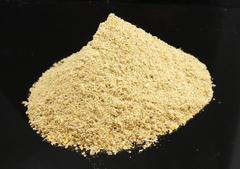
Roach Chow is important for gutloading your feeders, as this provides the most nutritious diet for your pets. Our roach chow is used in our facility to raise, grow and maintain our colonies at peak performance. This chow is plant based protein which mimics the wild Dubia diet.
Fresh fruits and vegetables are great for providing extra moisture and a varied diet. Any fresh food not eaten in a day will need to be removed to prevent mold growth.
Maintenance
Dubia roaches will do best if left alone as much as possible. It is best to check on them daily adding food and water as needed. The enclosure can go for quite a long time before it needs to be cleaned, depending on the amount of roaches in the enclosure. Once every month should be sufficient. It is okay to have frass on the bottom of the enclosure as the babies will burrow into it. To clean the enclosure just move your egg crates with the roaches on them to a new container. Pick out any remaining roaches and transfer them to the new container. Remove the frass and wipe the enclosure with a disinfectant such as Chlorhexidine.

